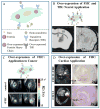MRI reporter genes: applications for imaging of cell survival, proliferation, migration and differentiation
- PMID: 23225197
- PMCID: PMC3713407
- DOI: 10.1002/nbm.2869
MRI reporter genes: applications for imaging of cell survival, proliferation, migration and differentiation
Abstract
Molecular imaging strives to detect molecular events at the level of the whole organism. In some cases, the molecule of interest can be detected either directly or with targeted contrast media. However many genes and proteins and particularly those located in intracellular compartments are not accessible for targeted agents. The transcriptional regulation of these genes can nevertheless be detected, although indirectly, using reporter gene encoding for readily detectable proteins. Such reporter proteins can be expressed in the tissue of interest by genetically introducing the reporter gene in the target cells. Imaging of reporter genes has become a powerful tool in modern biomedical research. Typically, expression of fluorescent and bioluminescent proteins and the reaction product of expressed enzymes and exogenous substrates were examined using in vitro histological methods and in vivo whole body imaging methods. Recent advances in MRI reporter gene methods raised the possibility that MRI could become a powerful tool for concomitant high-resolution anatomical and functional imaging and for imaging of reporter gene activity. An immediate application of MRI reporter gene methods was by monitoring gene expression patterns in gene therapy and in vivo imaging of the survival, proliferation, migration and differentiation of pluripotent and multipotent cells used in cell-based regenerative therapies for cancer, myocardial infarction and neural degeneration. In this review, we characterized a variety of MRI reporter gene methods based on their applicability to report cell survival/proliferation, migration and differentiation. In particular, we discussed which methods were best suited for translation to clinical use in regenerative therapies.
Copyright © 2012 John Wiley & Sons, Ltd.
Conflict of interest statement
None of the authors responsible for creation of this review article have any conflicts of interest to report.
Figures







References
-
- Waidmann MS, Bleichrodt FS, Laslo T, Riedel CU. Bacterial luciferase reporters: The Swiss army knife of molecular biology. Bioengineered Bugs. 2011;2(1):8–16. - PubMed
-
- Gilad A, Winnard PJ, van Zijl P, Bulte J. Developing MR reporter genes: promises and pitfalls. NMR in Biomed. 2007;20(3):275–290. - PubMed
-
- Shapiro EM, Skrtic S, Koretsky AP. Sizing it up: Cellular MRI using micron-sized iron oxide particles. Magn Reson Med. 2005;53(2):329–338. - PubMed
Publication types
MeSH terms
Grants and funding
LinkOut - more resources
Full Text Sources
Other Literature Sources
Medical

